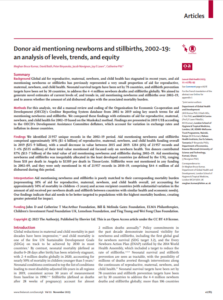
“Updated donor funding analyses covers almost two decades and builds on previous work led by The London School of Hygiene and Tropical Medicine (LSHTM) using the OECD database. In 2019, there was a large but static level of overseas aid funding at $15.9bn with only 10% mentioning newborns, and no increase since 2015 despite the first global Sustainable Development Goal (SDG) on neonatal survival. The term newborn was mostly found in the phrase MNCH, with very small amounts (0.4%) referring to specific high-impact interventions such as Kangaroo Mother Care (KMC). Most shockingly only 0.0003% of aid mentioned stillbirths or any linked term – only 47 times in the whole time period.
Most funding mentioning newborns and stillbirths was disbursed by the same few donors: in 2019, five bilateral donors disbursed 77% ($122bn) and ten donors disbursed 87% ($13.7bn) of the total. Aid disbursed was broadly aligned with burden and need but inconsistently targeted. National government funding is also crucial for scale-up but is more complex to track in comparable ways.” -Implementation Toolkit for Care of the Small and Sick Newborn
“Tracking aid is an important means of operationalizing accountability. Stated or rhetorical commitments are easy to make and funded priorities sometimes tell a different story – here, we see the great gap between the needs of the vulnerable (newborns and stillbirths) and their families and what we as a global community are committing in aid financing”
Dr Meghan Kumar, London School of Hygiene and Tropical Medicine